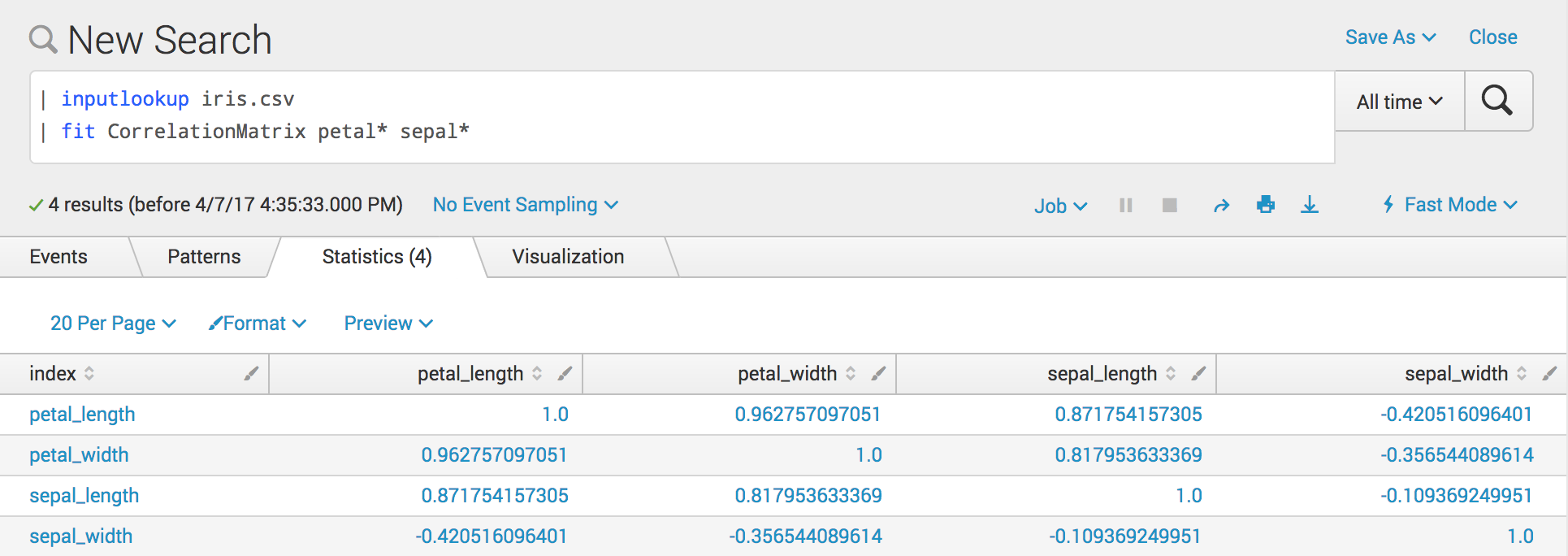Correlation Matrix example
This example uses the Python library pandas which is part of the Python for Scientific Computing app. This Correlation Matrix example covers the following tasks:
- Using the
BaseAlgoclass - Validating search syntax
- Converting parameters
The DataFrame.corr method constructs a correlation matrix. In addition to constructing the correlation matrix, you pass a parameter to the algorithm to switch between Pearson, Kendall and Spearman correlations. See the pandas library documentation for more information on this method.
A search using this custom algorithm looks like this:
index=foo sourcetype=bar | fit CorrelationMatrix method=kendall <fields>
Steps
Follow these steps to add the Correlation Matrix algorithm.
Fit a correlation matrix on all <fields>:
- Register the algorithm in
algos.confusing one of the following methods.
- Register the algorithm using the REST API:
$ curl -k -u admin:<admin pass> https://localhost:8089/servicesNS/nobody/Splunk_ML_Toolkit/configs/conf-algos -d name="CorrelationMatrix"
- Register the algorithm manually:
Modify or create thealgos.conffile located in$SPLUNK_HOME/etc/apps/Splunk_ML_Toolkit/local/and add the following stanza to register your algorithm:[CorrelationMatrix]
When you register the algorithm with this method, you must restart Splunk Enterprise.
- Register the algorithm using the REST API:
- Create the python file in the
algosfolder. For this example, you create$SPLUNK_HOME/etc/apps/Splunk_ML_Toolkit/bin/algos/CorrelationMatrix.py.
Import the relevant modules. In this case, use theBaseAlgoclass which provides a skeleton class to catch errors.from base import BaseAlgo
- Define the class.
Inherit fromBaseAlgo. The class name is the name of the algorithm.class CorrelationMatrix(BaseAlgo): """Compute and return a correlation matrix.""" - Define the
__init__method.
The__init__method passes the options from the search to the algorithm. Ensure that there are fields present and nofromclause and that only valid methods are used by raisingRuntimeErrorappropriately:def __init__(self, options): """Check for valid correlation type, and save it to an attribute on self.""" feature_variables = options.get('feature_variables', {}) target_variable = options.get('target_variable', {}) if len(feature_variables) == 0: raise RuntimeError('You must supply one or more fields') if len(target_variable) > 0: raise RuntimeError('CorrelationMatrix does not support the from clause') valid_methods = ['spearman', 'kendall', 'pearson'] # Check to see if parameters exist params = options.get('params', {}) # Check if method is in parameters in search if 'method' in params: if params['method'] not in valid_methods: error_msg = 'Invalid value for method: must be one of {}'.format( ', '.join(valid_methods)) raise RuntimeError(error_msg) # Assign method to self for later usage self.method = params['method'] # Assign default method & ensure no other parameters are present else: # Default method for correlation self.method = 'pearson' # Check for bad parameters if len(params) > 0: raise RuntimeError('The only valid parameter is method.')The options that are passed to this method are closely related to the SPL search query being used.
For a simple query such as:
| fit LinearRegression sepal_width from petal* fit_intercept=tThe options returned are:
{ 'args': [u'sepal_width', u'petal*'], 'params': {u'fit_intercept': u't'}, 'feature_variables': ['petal*'], 'target_variable': ['sepal_width'] 'algo_name': u'LinearRegression', }This dictionary of options includes:
- args (list) - a list of the fields used - params (dict) - any parameters (key-value) pairs in the search - feature_variables (list) - fields to be used as features - target_variable (list) - the target field for prediction - algo_name (str) - the name of algorithm
Other keys that may exist depending on the search:
- model_name (str) - the name of the model being saved ('into' clause) - output_name (str) - the name of the output ('as' clause)The
feature_fieldsandtarget fieldare related to the syntax of the search. If afromclause is present:| fit LinearRegression target_variable from feature_variableswhereas with an unsupervised algorithm such as KMeans:
| fit KMeans feature_variablesThe
feature_variablesin the options have not been wildcard matched against the available data. If there are wildcards (*) in the field names, the wildcards are present in thefeature_variables. - Define the
fitmethod.
Thefitmethod is where you compute the correlations. Afterwards, return the DataFrame.def fit(self, df, options): """Compute the correlations and return a DataFrame.""" # df contains all the search results, including hidden fields # but the requested requested are saved as self.feature_variables requested_columns = df[self.feature_variables] # Get correlations correlations = requested_columns.corr(method=self.method) # Reset index so that all the data are in columns # (this is usually not necessary, but is for the corr method) output_df = correlations.reset_index() return output_dfWhen defining the
fitmethod, you have the option to either return values or to do nothing, which returnsNone. If you return the dataframe, noapplymethod is needed. Theapplymethod is only needed when a saved model must make predictions on unseen data.
Finished example
from base import BaseAlgo
class CorrelationMatrix(BaseAlgo):
"""Compute and return a correlation matrix."""
def __init__(self, options):
"""Check for valid correlation type, and save it to an attribute on self."""
feature_variables = options.get('feature_variables', {})
target_variable = options.get('target_variable', {})
if len(feature_variables) == 0:
raise RuntimeError('You must supply one or more fields')
if len(target_variable) > 0:
raise RuntimeError('CorrelationMatrix does not support the from clause')
valid_methods = ['spearman', 'kendall', 'pearson']
# Check to see if parameters exist
params = options.get('params', {})
# Check if method is in parameters in search
if 'method' in params:
if params['method'] not in valid_methods:
error_msg = 'Invalid value for method: must be one of {}'.format(
', '.join(valid_methods))
raise RuntimeError(error_msg)
# Assign method to self for later usage
self.method = params['method']
# Assign default method and ensure no other parameters are present
else:
# Default method for correlation
self.method = 'pearson'
# Check for bad parameters
if len(params) > 0:
raise RuntimeError('The only valid parameter is method.')
def fit(self, df, options):
"""Compute the correlations and return a DataFrame."""
# df contains all the search results, including hidden fields
# but the requested requested are saved as self.feature_variables
requested_columns = df[self.feature_variables]
# Get correlations
correlations = requested_columns.corr(method=self.method)
# Reset index so that all the data are in columns
# (this is necessary for the corr method)
output_df = correlations.reset_index()
return output_df
Example search
You might have to reorder your fields with the fields or table command.
| Package an algorithm for Splunkbase | Agglomerative Clustering example |
This documentation applies to the following versions of Splunk® Machine Learning Toolkit: 4.4.0, 4.4.1, 4.4.2, 4.5.0

 Download manual
Download manual
Feedback submitted, thanks!